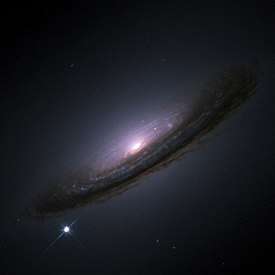Hubble bubble (astronomy)
In astronomy, a Hubble bubble would be "a departure of the local value of the Hubble constant from its globally averaged value,"[1] or, more technically, "a local monopole in the peculiar velocity field, perhaps caused by a local void in the mass density."[2]

The Hubble constant, named for astronomer Edwin Hubble, whose work made clear the expansion of the universe, measures the rate at which expansion occurs. In accordance with the Copernican principle that the Earth is not in a central, specially favored position, one would expect that measuring this constant at any point in the universe would yield the same value. If, on the other hand, Earth were at or near the center of a very low-density region of interstellar space (a relative void), denser material in a shell around it would strongly attract material away from the centerpoint. Thus, stars inside such a "Hubble bubble" would accelerate away from Earth much faster than the general expansion of the universe.[1][3] This situation would provide an alternative to dark energy in explaining the apparent accelerating universe.[3]
Hubble bubble proposed
In 1998, Zehavi et al. reported evidence in support of a Hubble bubble.[4] The initial suggestion that local redshift velocities differ from those seen elsewhere in the universe was based on observations of Type 1a supernovae, often abbreviated "SNe Ia." Such stars have been used as standard candle distance markers for 20 years, and were key to the first observations of dark energy.[5]
Zehavi et al. studied the peculiar velocites of 44 SNe Ia to test for a local void, and reported that Earth seemed to be inside a relative void of roughly 20% underdensity, surrounded by a dense shell, a "bubble".[4]
Testing the hypothesis
In 2007, Conley et al. examined the SNe Ia color data comparisons while taking into account the effect of cosmic dust in external galaxies. They concluded that the data did not support the existence of a local Hubble bubble.[2]
In 2010, Moss et al. analyzed the Hubble Bubble model although without using that name,[1] saying "The suggestion that we occupy a privileged position near the center of a large, nonlinear, and nearly spherical void has recently attracted much attention as an alternative to dark energy."[3] Looking not only at supernova data but also at the cosmic microwave background spectrum, Big Bang nucleosynthesis and other factors, they concluded that "voids are in severe tension with the data. In particular, void models predict a very low local Hubble rate, suffer from an "old age problem", and predict much less local structure than is observed."[3]
References
- "Hubble Bubble". The Astronomist. 29 July 2010. Retrieved 2 February 2011.
- Conley, A; RG Carlberg; J Guy; DA Howell; S Jha; A Riess; M Sullivan (2007). "Is there evidence for a Hubble Bubble? The nature of Type Ia supernova colors and dust in external galaxies". Astrophysical Journal. 664 (1): L13–L16. arXiv:0705.0367. Bibcode:2007ApJ...664L..13C. doi:10.1086/520625.
- Moss, Adam; James P Zibin; Douglas Scott (2011). "Precision Cosmology Defeats Void Models for Acceleration". Physical Review D. 83 (10): 103515. arXiv:1007.3725. Bibcode:2011PhRvD..83j3515M. doi:10.1103/PhysRevD.83.103515.
- Zehavi, Idit; Adam G Riess; Robert P Kirshner; Avishai Dekel (1998). "A Local Hubble Bubble from Type IA Supernovae?". Astrophysical Journal. 503 (2): 483. arXiv:astro-ph/9802252. Bibcode:1998ApJ...503..483Z. doi:10.1086/306015.
- Overbye, Dennis (February 22, 2010). "From the Clash of White Dwarfs, the Birth of a Supernova". New York Times. Retrieved 6 February 2011.
See also
- Local Void
- Giant Void
- Large-scale structure of the cosmos
- Void (astronomy)
- List of largest voids